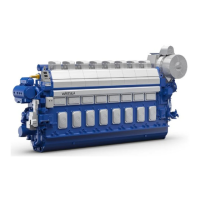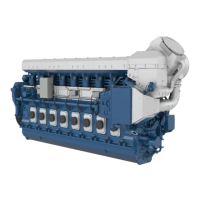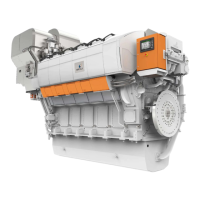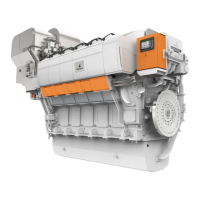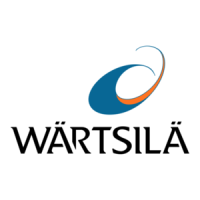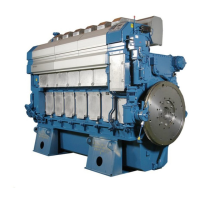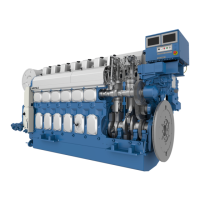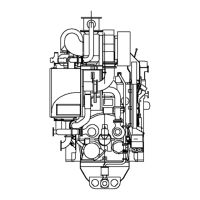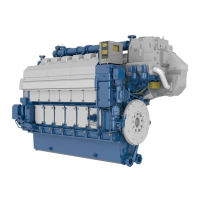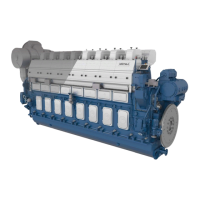
Do you have a question about the Wartsila 46F and is the answer not in the manual?
| Bore | 460 mm |
|---|---|
| Stroke | 580 mm |
| Fuel Type | Heavy fuel oil, marine diesel oil |
| Cylinder Configuration | V-type |
| Type | 4-stroke |
| Speed | 500 rpm |
| Number of Cylinders | 6 - 20 |
| Weight | Approx. 90 tons (varies by configuration) |
Engine power output specifications.
Standard conditions for engine performance data.
Engine operating limits at various inclinations.
Physical size and mass of engine configurations.
Defines engine operational limits and conditions.
Guidelines for engine load acceptance and increase rates.
Recommendations for engine operation at reduced loads.
Considerations for engine operation in cold environments.
Overview of engine technical data and auxiliary systems.
Detailed technical specifications for the 6L46F engine.
Detailed technical specifications for the 7L46F engine.
Detailed technical specifications for the 8L46F engine.
Detailed technical specifications for the 9L46F engine.
Detailed technical specifications for the 12V46F engine.
Detailed technical specifications for the 14V46F engine.
Detailed technical specifications for the 16V46F engine.
Glossary of engine-related terms and diagrams.
Overview of major engine parts and their functions.
Visual representation of engine internal structure.
Maintenance schedules and component lifespan data.
Guidelines for storing the engine.
Guidelines for selecting pipe sizes based on various factors.
Requirements for heating critical pipes.
Standards for piping pressure rating and safety.
Classification of piping systems based on DNV rules.
Recommendations for pipe insulation.
Fuel specifications and properties for engine operation.
Diagram and components of the engine's internal fuel system.
Design and requirements for the ship's fuel supply system.
Specifications for engine lubricating oil based on fuel type.
Diagram and components of the engine's internal lubrication system.
Design and components for the external lubricating oil system.
Requirements for air used in control and instrumentation.
Engine's internal compressed air system components and functions.
Design considerations for the ship's external compressed air system.
Required quality standards for engine cooling water.
Diagram and components of the engine's internal cooling system.
Design and components for the ship's external cooling water system.
Importance of engine room ventilation for equipment and air supply.
Principles for designing the engine's combustion air intake system.
Components and diagrams of the engine's internal exhaust system.
Specifications for the engine's exhaust pipe diameters and supports.
Design factors for the ship's external exhaust gas piping.
Description of the automatic turbocharger cleaning system.
Breakdown of exhaust gas components and their formation.
Overview of international and local marine emission regulations.
Strategies for reducing engine exhaust emissions.
System specifications, ingress protection, and ambient temperature limits.
Engine control functions including start, stop, speed control, and blockings.
Information on engine sensors, signals, and alarm configurations.
Details on motor starters and electrically driven pumps.
Guidelines for load control, synchronization, and engine response.
Design considerations for the engine foundation steel structure.
Methods for mounting engines, including rigid and resilient types.
Dynamic forces and couples generated by engine configurations.
Engine torque variations at full load.
Inertia values for rotating parts and vibration dampers.
Typical levels of noise transmitted through structures.
Typical sound power levels of engine airborne noise.
Typical sound power levels of exhaust noise.
Engine connection via flexible couplings for torsional vibration.
Use of clutches for engine separation and maintenance.
Device to secure propeller shaft and prevent wind milling.
Utilizing engine output from the free end.
Data required for shaft line torsional vibration analysis.
Engine turning gear specifications and applications.
Minimum spacing between engines for operation and maintenance.
Required working space, engine room height, and platform considerations.
Procedures for moving and storing engine parts and tools.
Space needed for dismantling and cleaning during overhaul.
Dimensions and weights for lifting in-line engine configurations.
Dimensions and weights for lifting V-engine configurations.
Dimensions and weights of major engine components.
Tables for converting between different unit systems.
Reference list of standard drawing symbols used in the manual.
